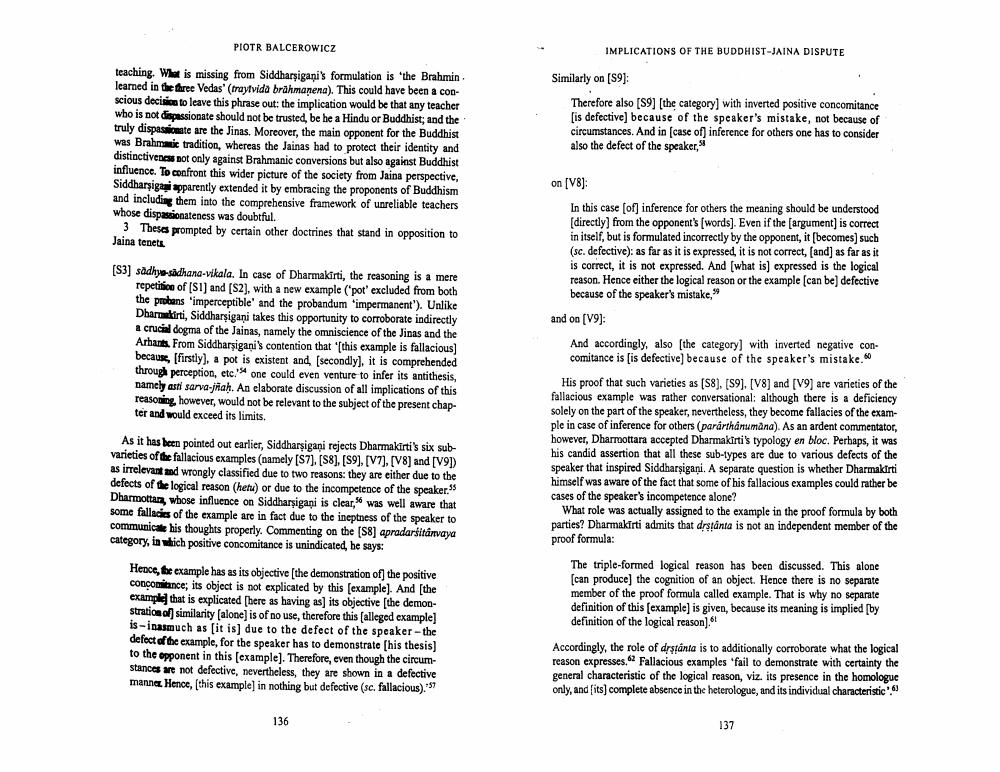________________
PIOTR BALCEROWICZ
IMPLICATIONS OF THE BUDDHIST-JAINA DISPUTE
Similarly on (59):
Therefore also [59] (the category] with inverted positive concomitance
is defective) because of the speaker's mistake, not because of circumstances. And in case of) inference for others one has to consider also the defect of the speaker,
teaching. What is missing from Siddharşigani's formulation is the Brahmin learned in the three Vedas' (traytvida brahmanena). This could have been a cooscious decision to leave this phrase out: the implication would be that any teacher who is not dispassionate should not be trusted, be be a Hindu or Buddhist; and the truly dispassionate are the Jinas. Moreover, the main opponent for the Buddhist was Brahmatic tradition, whereas the Jainas had to protect their identity and distinctiveness not only against Brahmanic conversions but also against Buddhist influence. To confront this wider picture of the society from Jaina perspective, Siddharsigapparently extended it by embracing the proponents of Buddhism and including them into the comprehensive framework of unreliable teachers whose dispassionateness was doubtful.
3 Theses prompted by certain other doctrines that stand in opposition to Jaina tenets
on [V8]:
[53] sadhye-sadhana-vikala. In case of Dharmakirti, the reasoning is a mere
repetition of (SI) and (S2], with a new example ('pot' excluded from both the probans 'imperceptible' and the probandum 'impermanent'). Unlike Dharukirti, Siddharsigani takes this opportunity to corroborate indirectly a crucial dogma of the Jainas, namely the omniscience of the Jinas and the Arhants. From Siddharsigani's contention that " (this example is fallacious) because, [firstly), a pot is existent and secondly), it is comprehended through perception, etc. one could even venture to infer its antithesis, namely asti sarva.jrah. An elaborate discussion of all implications of this reasoning, however, would not be relevant to the subject of the present chapter and would exceed its limits.
In this case (of inference for others the meaning should be understood [directly from the opponent's words). Even if the argument is correct in itself, but is formulated incorrectly by the opponent, it becomes] such (sc. defective); as far as it is expressed it is not correct, (and) as far as it is correct, it is not expressed. And what is expressed is the logical Teason. Hence either the logical reason or the example (can be defective
because of the speaker's mistake, and on (V9):
And accordingly, also the category] with inverted negative con
comitance is [is defective) because of the speaker's mistake. His proof that such varieties as (58), ($9), (V8) and (V9) are varieties of the fallacious example was rather conversational: although there is a deficiency solely on the part of the speaker, nevertheless, they become fallacies of the example in case of inference for others (pararthanumana). As an ardent commentator, however, Dharmottar accepted Dharmakirti's typology en bloc. Perbaps, it was his candid assertion that all these sub-types are due to various defects of the speaker that inspired Siddharsigani. A separate question is whether Dharmakirti himself was aware of the fact that some of his fallacious examples could rather be cases of the speaker's incompetence alone?
What role was actually assigned to the example in the proof formula by both parties? Dharmakirti admits that drstanta is not an independent member of the proof formula:
As it has been pointed out earlier, Siddharşigani rejects Dharmakirti's six subvarieties of the fallacious examples (namely (S7). [S8], [S9), [V7), [V8] and [V91) as irrelevant and wrongly classified due to two reasons: they are either due to the defects of the logical reason (hetu) or due to the incompetence of the speaker." Dharmottan whose influence on Siddharsigani is clear,was well aware that some falladies of the example are in fact due to the ineptness of the speaker to communicate his thoughts properly. Commenting on the (S8) apradaršitánvaya category, in which positive concomitance is unindicated, he says:
Hence, the example has as its objective (the demonstration of the positive Concomitance; its object is not explicated by this example). And the example that is explicated [here as having as its objective (the demonstration of similarity (alone) is of no use, therefore this (alleged example) is - inasmuch as it is due to the defect of the speaker-the defect of the example, for the speaker has to demonstrate [his thesis) to the opponent in this example). Therefore, even though the circumstances are not defective, nevertheless, they are shown in a defective manna. Hence, (this example) in nothing but defective (sc. fallacious).***
The triple-formed logical reason has been discussed. This alone (can produce) the cognition of an object. Hence there is no separate member of the proof formula called example. That is why no separate definition of this example) is given, because its meaning is implied [by definition of the logical reason).
Accordingly, the role of drstanta is to additionally corroborate what the logical reason expresses. Fallacious examples 'fail to demonstrate with certainty the general characteristic of the logical reason, viz. its presence in the homologue only, and its complete absence in the heterologue, and its individual characteristic'.
136
137




